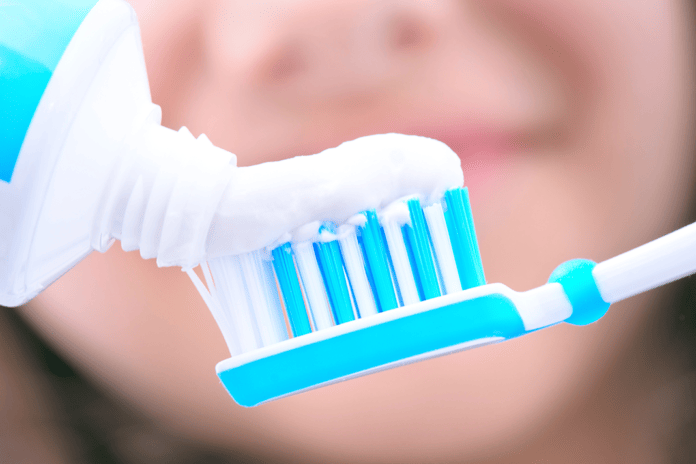Dentin hypersensitivity (DH) is a prevalent complaint among dental patients. When patients complain of a sharp, transient toothache, especially when ingesting something hot or cold, dentin hypersensitivity may be the culprit.
A 2018 study published in Nature published by Hiller et al. examined how effectively three kinds of toothpaste blocked the dentinal openings which lead to the symptoms of dentin hypersensitivity. The active substances investigated included hydroxyapatite, potassium nitrate, and an arginine-and-calcium carbonate. Because saliva can react with these components and alter their structures, the study also examined their effectiveness with and without saliva.
The Physiology of Dentinal Permeability
Dentin is composed of tubules that run perpendicularly from the outer surface of the dentin to the pulp. Each tubule is approximately 1-2 µm in diameter, and a 1-2mm area contains an average of 30,000 dentin tubules. Inorganic materials comprise nearly 70% of dentin’s structure, and the calcium-phosphate crystals, hydroxyapatite, are an essential component.
Dentin can become exposed, however. Exposed dentin can occur because of periodontal disease, abrasion, or enamel erosion. When external substances encounter dentin, a piercing pain often ensues. Temperature, physical contact, osmosis, or possibly certain molecules can trigger sensitivity. The discomfort may be mild, or it could severely hamper someone’s quality of life.
Various Treatments Are Available
Treating dentinal hypersensitivity can be approached via various modalities.
Dental professionals can desensitize the tooth’s nerves by applying compounds that reduce the excitability of the nerve fibers within the pulp. Potassium ions block the action potential of nerves, so potassium-containing salts such as potassium nitrate are frequently used to lessen DH symptoms.
Other treatments involve substances that precipitate proteins, such as silver nitrate or zinc chloride. Additionally, dental professionals can seal the tooth with a dentinal adhesive or use laser therapy. Also, endodontic treatments and resin restorations may be employed.
Another inexpensive and feasible approach involves advising patients to use a toothpaste or mouthwash containing substances that coat the tooth and occlude the dentinal tubules. This method doesn’t disrupt their current dental hygiene practices; it merely swaps their current oral products with ones that curtail the sensitivity.
Testing the Effectiveness of 3 Substances that Block Dentinal Openings
The Hiller et al. study examined the effectiveness of toothpastes containing hydroxyapatite, potassium nitrate, and an arginine-and-calcium carbonate, respectively. The researchers compared dentinal permeability of these substances both in the presence of saliva and without.
The experiments were conducted using 200-µm thick dentin slices from cows since it is physiologically similar to human dentin. When saliva was included in the trials, it was sourced from two healthy human donors and then filtered.
Researchers tested the permeability of the dentin by measuring the dentin’s hydraulic conductance L P and visualizing it with scanning electron microscopy. Thermal aging was conducted by immersing the dentin in 5°C- and 55°C- water baths for 30 seconds in 100-repetition cycles.
To simulate real-world conditions as much as possible, the researchers used a constant, low pressure of 13.8 kPa to perfuse the liquid through the dentinal tubules. They analyzed the liquid flowing through the tubules for 2 minutes each time.
Blocking Dentin Permeability Differs with or without Saliva
The study indicated that all 3 of the tested substances were able to block the dentin tubules and alter the permeability of dentin to some degree, but the results differed regarding the presence or absence of saliva.
In the absence of saliva, the hydroxyapatite-containing toothpaste blocked the dentin tubules the best. Results showed the hydroxyapatite caused dentin to exhibit a permeability of 61%.
Applying potassium nitrate caused the dentin to display a permeability of 87%, while the arginine-and-calcium carbonate toothpaste blocked the dentin tubules the least. Dentin had a 118% permeability when treated with the arginine-and-calcium carbonate.
In the presence of saliva, however, the results differed. With saliva, the arginine-and-calcium carbonate blocked the tubules and decreased dentin’s permeability the best.
People often brush their teeth more than once a day, so the researchers repeatedly applied the toothpastes. The results indicated that repeated application reduced the dentin’s permeability. However, the thermal aging tests showed an increase in permeability over time, regardless of whether saliva was present or not.
In conclusion, hydroxyapatite-containing toothpaste was the most effective substance to block dentinal tubules and decrease dentin permeability in the absence of saliva. However, a toothpaste containing arginine-and-calcium carbonate was the best tubule-blocker in the presence of saliva. Potassium nitrate ranked in the middle.
Dentin hypersensitivity is a widespread complaint with a variety of contributing factors. Treating the sensitivity with tubule-blocking compounds can reduce the pain and improve the quality of life of patients. Using arginine-and-calcium carbonate in the presence of saliva reduces dentin permeability the most, but implementing a solution containing hydroxyapatite reduces dentinal permeability the most in the absence of saliva.
SEE ALSO: Charcoal Whitening Toothpaste Trend: Should it Stay or Fade Away?
DON’T MISS: 5 Reasons Why You Might Have Sensitive Teeth











